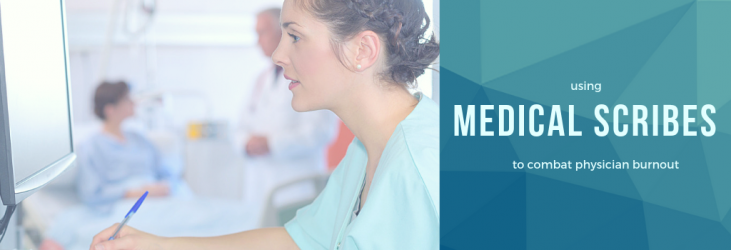
Physician Wellness Series Part 1: Using Medical Scribes to Combat Burnout
Cortney Ikpe
As physician burnout takes center stage in today’s medical news, it has become increasingly important to seek out solutions to this widespread epidemic - not only for the sake of physician performance, but for their mental health and well-being as people. In this three-part series, we will discuss three possible ways a physician can combat burnout and pursue wellness in his or her profession, including:
1. The use of medical scribes
2. In-house physician wellness programs
3. Increasing skills in emotional intelligence
Using Medical Scribes to Combat Burnout
Countless reports have cited exhaustive EHR (Electronic Health Record) requirements as one of the major causes of burnout, preventing physicians from spending as much time in person with their patients and adding more hours to their already-heavy workloads. The use of medical scribes may significantly reduce this problem.
In an article by Medscape, a 12-month study was conducted to evaluate physicians’ experiences with scribes. The results showed that using medical scribes significantly improved physicians’ overall performance in the following ways.
- Medical scribes reduced EHR burden during on-and-off hours. More physicians reported spending less time working on EHR documentation after-hours when given a scribe (>1 hour). Physicians given scribes were also more likely to meet their their target time of completing their patient’s visit documentation.
- Physician-patient interaction was improved. More physicians reported spending 75% or more of appointment time interacting with patients when a scribe was present. Patient satisfaction scores were significantly improved for physicians with scribes, and a majority of patients held a positive view of scribes present during their appointment.
- Job satisfaction increased. 17 out of 18 physicians in the study reported greater job satisfaction when given a scribe.15 of 17 physicians were satisfied with the scribes’ quality of work, and 11 would be open to adding more patients if they had a full-time scribe.
But what is a medical scribe, exactly, and how can a physician get one?
Also known as a physician scribe, these people accompany a physician during appointments with patients and record all of the relevant data to be used as part of the patient’s record. This profession is fast-growing, with 18,000 in the United States right now and a projected number of 100,000 by 2020, according to ScribeAmerica. Generally, the minimum qualification for a person to become a scribe is a high school diploma, but pre-med students often work in this position to gain experience shadowing physicians.
Getting your contract reviewed has numerous benefits beyond just compensation and non-competes. Negotiating items like a scribe or a PA can dramatically improve your work-life balance and allow you to spend more time with patients. Our trained team of attorneys can also pick out red flags in your employment agreement and uncover hidden meanings and implications within the fine lines of your contract. Using our services could significantly improve the quality of your work, thus improving your work satisfaction. Don’t miss out on this opportunity. Contact one of our specialists today to get your contract negotiated.